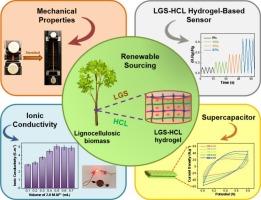A sustainable approach for harnessing the synergy between lignosulfonate and hemicellulose: Towards next-generation bio-derived flexible electronics
IF 8.5
1区 化学
Q1 BIOCHEMISTRY & MOLECULAR BIOLOGY
International Journal of Biological Macromolecules
Pub Date : 2025-09-29
DOI:10.1016/j.ijbiomac.2025.147985
引用次数: 0
Abstract
The preparation of high-performance conductive hydrogels from renewable and biodegradable materials has received widespread attention in the development of soft electronic devices. However, challenges remain in effectively balancing the functionality, conductivity and mechanical stability of hydrogel-based flexible systems. Enlightened by the synergistic interactions between two naturally abundant biopolymers, lignosulfonate (LGS) and hemicellulose (HCL), a robust and highly conductive LGS-HCL hydrogel was prepared in this study by using LGS, HCL, acrylic acid (AA) and AlCl3. A dynamic redox process involving Al3+/Al2+ and hydroquinone/quinone couple triggered the rapid exothermic polymerization reaction under the influence of ammonium persulfate (APS). Effective hydrogen and metal-coordination bonds between LGS, HCL, polyacrylic acid (PAA) and Al3+ endowed the hydrogel with exceptional mechanical properties. A maximum tensile strength of ∼0.501 MPa at an elongation of 1089 % and a maximum compressive strength of ∼0.962 MPa with the highest stretchability of 70 % were demonstrated by the synthesized hydrogel. The wearable LGS-HCL hydrogel-based strain sensor can monitor various human motions with a tunable conductivity (up to 5.02 S·m−1), a high sensitivity (a maximum gauge factor of 2.48) and long cyclic stability (500 cycles). In addition, the supercapacitor device, assembled from the polyaniline (PANI)@carbon cloth (CC) electrodes and the LGS-HCL hydrogel electrolyte, exhibited specific capacitance (Cs), highest energy density (Ed) and power density (Pd) of 379.3 F·g−1, 33.71 Wh·kg−1 and 3.20 kW·kg−1, respectively. This work paves the way for the integration of renewable, biodegradable materials in the next generation of sustainable and high-performance flexible electronic devices.

利用木质素磺酸盐和半纤维素之间的协同作用的可持续方法:迈向下一代生物衍生的柔性电子产品
利用可再生和可生物降解材料制备高性能导电水凝胶在软性电子器件的发展中受到广泛关注。然而,如何有效地平衡水凝胶基柔性系统的功能、导电性和机械稳定性仍然存在挑战。本研究利用两种天然丰富的生物聚合物木素磺酸盐(LGS)和半纤维素(HCL)之间的协同作用,以LGS、HCL、丙烯酸(AA)和AlCl3为原料制备了一种坚固、高导电性的LGS-HCL水凝胶。在过硫酸铵(APS)的作用下,Al3+/Al2+和对苯二酚/醌对的动态氧化还原过程引发了快速放热聚合反应。LGS、HCL、聚丙烯酸(PAA)和Al3+之间有效的氢金属配位键使水凝胶具有优异的力学性能。合成的水凝胶的最大抗拉强度为~ 0.501 MPa,伸长率为1089%;最大抗压强度为~ 0.962 MPa,拉伸率为70%。可穿戴的LGS-HCL水凝胶应变传感器可以监测各种人体运动,具有可调的电导率(高达5.02 S·m−1),高灵敏度(最大测量因子2.48)和长周期稳定性(500次循环)。此外,由聚苯胺(PANI)@碳布(CC)电极和LGS-HCL水凝胶电解质组装而成的超级电容器器件,其比电容(Cs)、最高能量密度(Ed)和功率密度(Pd)分别为379.3 F·g−1、33.71 Wh·kg−1和3.20 kW·kg−1。这项工作为可再生、可生物降解材料在下一代可持续和高性能柔性电子设备中的整合铺平了道路。
本文章由计算机程序翻译,如有差异,请以英文原文为准。
求助全文
约1分钟内获得全文
求助全文
来源期刊
CiteScore
13.70
自引率
9.80%
发文量
2728
审稿时长
64 days
期刊介绍:
The International Journal of Biological Macromolecules is a well-established international journal dedicated to research on the chemical and biological aspects of natural macromolecules. Focusing on proteins, macromolecular carbohydrates, glycoproteins, proteoglycans, lignins, biological poly-acids, and nucleic acids, the journal presents the latest findings in molecular structure, properties, biological activities, interactions, modifications, and functional properties. Papers must offer new and novel insights, encompassing related model systems, structural conformational studies, theoretical developments, and analytical techniques. Each paper is required to primarily focus on at least one named biological macromolecule, reflected in the title, abstract, and text.

 求助内容:
求助内容: 应助结果提醒方式:
应助结果提醒方式:


